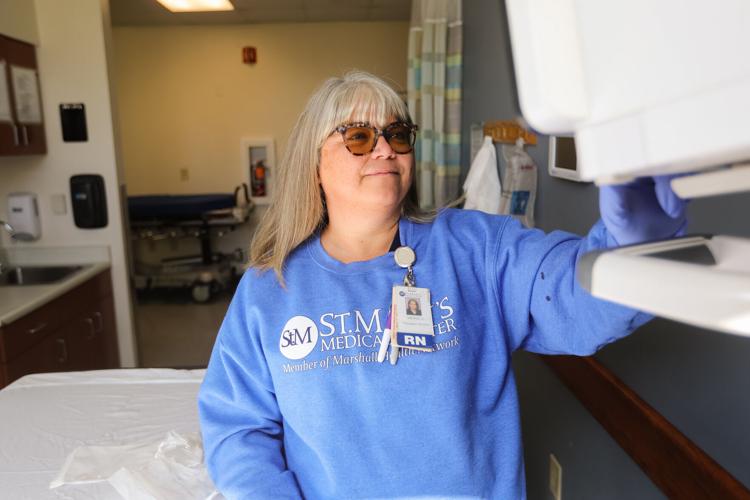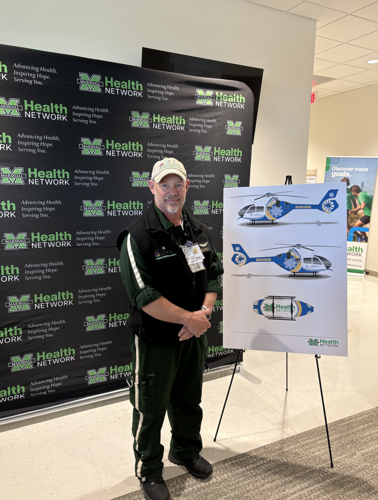HUNTINGTON — Most people have seen at least one or two scenes from a TV medical drama at some point: Everything is always high stakes, high stress and fast-paced. And the patient’s diagnosis is never the most obvious one.
Monica Scarberry is a registered nurse in the emergency department at St. Mary’s Medical Center but she has experience in several areas. She also took time off when she was sick, an experience that provided her with a new look at medical facilities and staff.
“Being a patient gives you a unique perspective about what they need at the bedside or what they’re looking for in terms of support and explanation, comfort,” Scarberry said. “So I think that made me a better nurse.”
One of the biggest defining characteristics about the ER is the variety of patients she sees every day. Some patients will have injuries from car accidents on the interstate, while others may have been injured at home in accidents ranging from cut fingers to major trauma.
“It’s never a dull shift and you never know what you’re going to get, but the same principles apply. You care for the whole person and try to explain to them what’s going on. I want to provide care that we do things with the patient, not that we do things to them. I want them to understand what we’re doing and participate in the plan of care that way when they’re discharged, they have a better chance for success,” she said.
She also said that more people in the ER have preexisting conditions, on top of the reason they are seeking emergency care.
“Today, compared to when I first started years ago in the emergency room, I see more complex health conditions, comorbidities, untreated chronic conditions, and the impact of things like hypertension, obesity, diabetes, and how they can affect the current situation,” she said. “You may be here for an accident, but if you are a diabetic and you have very high blood pressure, that will affect the way we need to take care of you today. I see more complex mental health issues. I see more addiction ... than I did in my previous years.”
It’s a lot to balance, but her rotation schedule helps. She has a week off every other week.
“I like my gardening. I love my dog. I have hobbies like everybody else has,” she said. “Everything just becomes more meaningful when you realize how fragile life is. You enjoy your time at home in peace and quiet when you read, or when you cook, or even cleaning your house. You appreciate the things that this job does afford you.”
Russell Houck is a transport nurse for the Marshall Health Network pediatric intensive care unit at Hoops Family Children’s Hospital. His team transports children who are in ERs and stabilizes them as they are transported to other facilities by helicopter or ground transport.
“As we fly, we do all the stabilization for anybody from birth to 21 and even greater in age from establishing and maintaining an airway, keeping their heart rate, their blood pressure, and then placing any lines or anything that they need as well,” Houck said.
He compared it to a mini ICU.
“We have protocols that we go by that are established by our physicians that we can maintain and do all the things that would maintain them, just like if you’re in the ER in an emergency situation,” he said.
In the air, the work is different because staff members usually are buckled in, he added.
“We have to have contact with the pilot and the other paramedic, and if anything happens en route, then we establish with the pilot what we’re going to do and then we can manipulate everything in the helicopter for us to work just like you would in the hospital.”
This wasn’t his first career choice. He majored in business at Marshall University and then joined the U.S. Air Force where he trained as an air medical technician.
“I really enjoy watching all the things that people do to make children and other people better,” he said. “But just to see 90% of our patients get better is a thrill.”
Each of his shifts is 24 hours, starting at 8 a.m. and ending at 8 a.m. the next day. He says that there are some periods of downtime where you can nap in the call room but there are also days where you’re working the majority of the shift. He said that if a situation becomes overwhelming, they can always call for backup.
“I try to stay humble and realize that sometimes what I think is going to be the easy way to go or the simplest way to go, sometimes changes and it gets into the hardest way to go and then just try to reflect and realize that God has placed me there for a reason, so to be humble is the biggest thing,” he said.
He would encourage anyone with an interest to go into nursing, saying “it’s the most fantastic thing you can ever do.”














